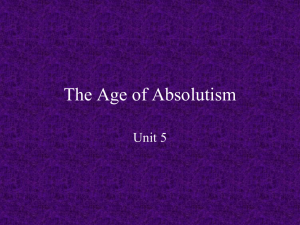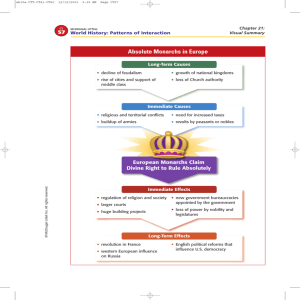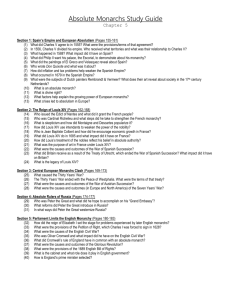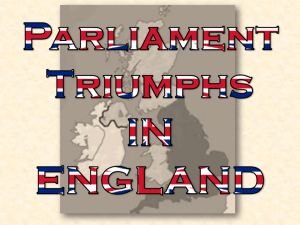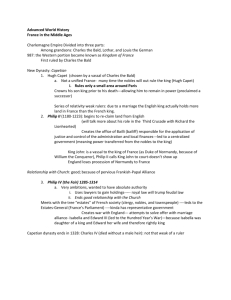Royal Power and Conflict
advertisement
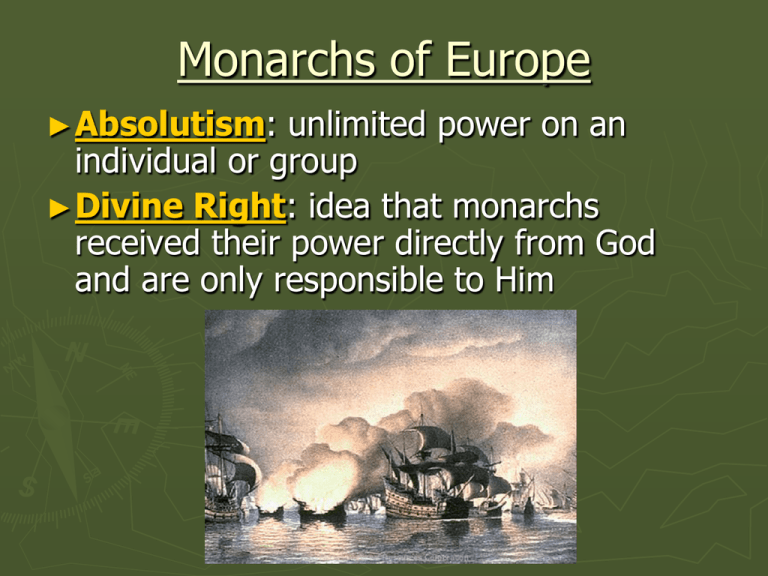
Monarchs of Europe ► Absolutism: unlimited power on an individual or group ► Divine Right: idea that monarchs received their power directly from God and are only responsible to Him Spanish Monarchs ► Charles Emperor V: Holy Roman Divided Hapsburg lands between Ferdinand (brother) and Philip II (son) ► Philip II (r. 1556-1598) “Defender of the Catholic Faith” ► Dutch Independence Prudent King (cautious and hardworking) Unified the Government (capital city – Madrid) Phillip II “Defender of the Faith” ► Spanish Armada Fleet of warships; sent to attack England Convert England to Catholicism 130 ships; 20,000 men ► Armada would hold English Channel for Army of Flanders invasion 6 day delay 6 fire ships Large Spanish galleons defeated by smaller English ships ► Battle of Gravelines Spanish forced to retreat North Result: Spain & Catholicism show weakness “Golden Century” (1550-1650) ► ► ► ► Cervantes – Don Quixote Inflation became a concern Influx of gold and silver from their American colonies Relied on agriculture Lagged behind other industrialized countries Philip II’s successors lacked governing skills Charles II (r. 1665-1700) ► Was physically and mentally weak Known as Charles the Mad ► No heirs to the throne ► European monarchs plotted for control The Tudor Dynasty English Monarchs (Tudors) ► Henry VII (r. 1485-1509) Aristocracy became dependent on the crown Used diplomacy to avoid war Used marriages to strengthen royal power ► Henry VIII (r. 1509-1547) Viewed as the most powerful Tudor monarch Developed a strong Navy Married six times Worked with Parliament to accomplish his goals Seized monastic lands and redistributed them ► Edward VI (r. 1553-1558) Inherited the throne at 9 yrs. old – died at 15 yrs. old ► Mary I (r. 1553-1558) Was devoutly Catholic; supported by the people Married Philip II of Spain; restored Catholicism Went to war with France – lost the port of Calais Died in 1558 without an heir to the throne ► Elizabeth I (r. 1558-1603): Also known as the “Virgin Queen” Speculation on who would succeed her Respected by her subjects Elizabethan Court & Government: advised by nobles Social & Economic Policy: (monarch, gentry, yeomen) ► Statute of Apprentices (1563); Poor Laws (1595 & 1601) Foreign Policy: Relied on the Channel for protection ► Mary Queen of Scots The End of the Tudor Dynasty ► Elizabeth did not leave an heir ► 1603: The English throne passed to James Stuart of Scotland (Mary Q. of Scots’ son) ► King James VI (I): United England and Scotland Began the Stuart Dynasty French Monarchs (The Bourbons) ► Henry IV (r. 1589-1610): Henry of Navarre Edict of Nantes (1598): allowed Protestantism Restored the crown’s treasury, repaired roads, etc. Tried to restore discipline to the military Laid the foundation of absolutism ► Cardinal Richelieu: Louis XIII gave power over to him Destroyed castles to end noble control of France Gave local authority to intendants, non-nobles 1625: Huguenots revolted against Louis XIII ►Lost at La Rochelle (1628) ►Lost rights to live in independent towns ► Louis XIV (r. 1643-1715) Became king at age 5, began to rule alone at 23 Absolute Rule: ►Feared disorder if a strong monarchy did not exist ►Lived through the Fronde as a youth ►Supported by the church (Jacques Bossuet) Court Life: ►Moved the government and courts to Versailles ►Kept a close eye on his nobles Government Policies: ►Carefully chose advisors ►Separate authorities for separate duties ►Two key aides: Colbert and Tellier ► Louis XIV (continued) Taxation ►Tax burden was on the poor ►Little desire for higher output b/c of higher taxes Religious Policy ►Persecuted Huguenots; many left France ►1685: repealed the Edict of Nantes Expansion and Conflict (War of Spanish Succession) ►England, Austria, and the Dutch allied together ►Treaty of Utrecht: France and Spain can’t unite Legacy ►Brilliant cultural period ►Nobles lost ability to govern ►Peasants and middle-class resented the wealthy ►Nobles wanted to regain power under Louis XV “The New Roman Empire” ► Charles V tried to revive the H.R.E. as the strong center of trade/politics in Europe ► Unlike the Eastern Empires – individual states developed independently Protestant Reformation allowed a political gathering and stronghold for German princes Attacks from the French and Ottoman Empire proved to be to much on the defense German Monarchs (The Hapsburgs) ► Thirty Years’ War: Religious conflict continued after the Peace of Ausburg Ferdinand of Stryia was in favor of the Hapsburgs and caused the Czechs to revolt Spain sent aid – Denmark, England, and Sweden joined together against the Hapsburgs Approx. 1/3 of German population killed Peace of Westphalia: recognized Calvinism as a religion ► Austria: received land in Italy and the Netherlands Pragmatic sanction: allowed female succession and stated that Hapsburg land could not be divided Maria Teresa succeeded Charles VI in 1740 ►Strengthened the Austrian throne - improved bureaucracy ► Prussia: enemy of Austria during the 1700s Ruled by the Hohenzollerns Fredrick William “the Great Elector”: ►Allied with the Junkers (nobles) = absolute power ►Only nobles could own land, exempt from taxes ►Fredrick I inherited the throne (weak ruler) Fredrick William I: a powerful ruler ►United all functions into one beaucracy ►Devoted to the military (regiment of giants) Fredrick II “Fredrick the Great”: ►Rejected the pragmatic sanction (seized Austrian land) ►1748: the Treaty of Aix-la-Chapelle ►1756-1763: Seven Years War: G.B. & France competed for land (ended with the Treaty of Paris)
